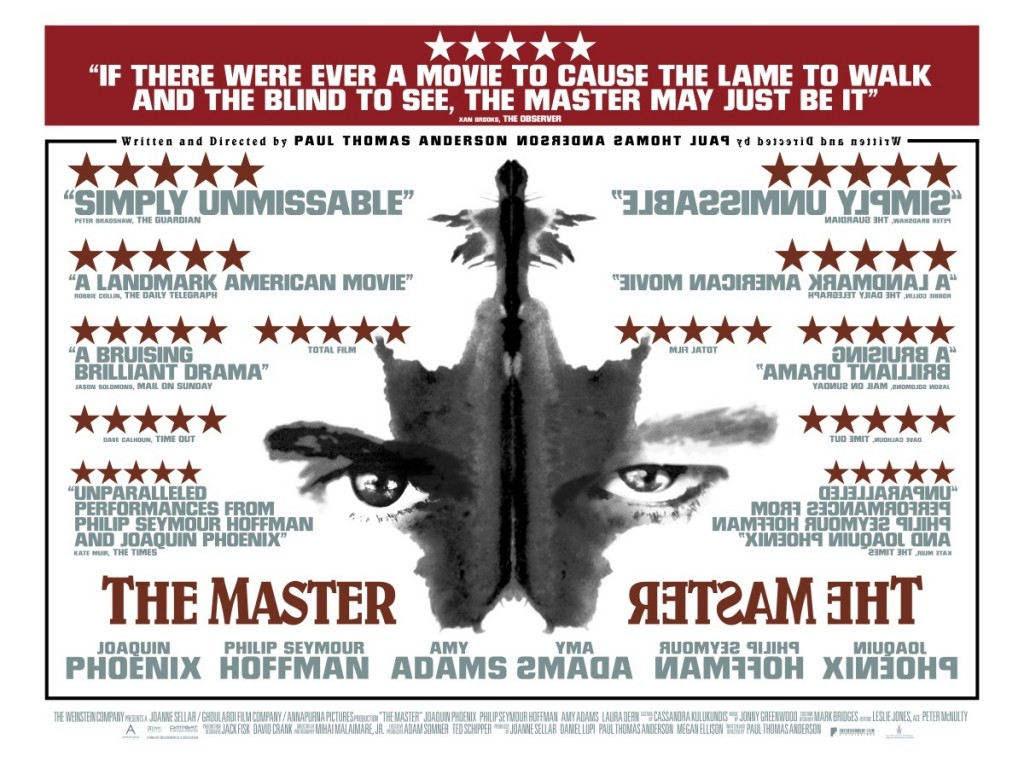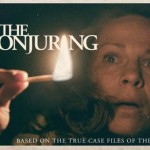Paul Thomas Anderson’s “The Master” is now available for mass consumption in home viewing form, and now it can be seen by many more people, many of whom will be downright flummoxed by this film, a strange and meandering tale of two men and their friendship forged through some psychotherapy and a shared love of harsh drink. Oh, and one of those guys is starting a weird cult-like group that has more than a thing or two in common with Scientology.
The movie starts with Freddie Quell (Joaquin Phoenix, Walk the Line) in the Navy during World War II, but he isn’t shown doing any war type things. Instead he’s on a beach with a bunch of other naval men, doing different things like cutting up coconuts and wrestling around and making a large naked woman out of sand, and in most of these things, it is already obvious that Freddie is a little off. And when he’s on the ship with everyone, he siphons fuel from torpedoes and drinks it to get hammered and then passes out on a high perch where other sailors can through shit at him. And while we don’t see him in combat, we do get to see his exit interview from a VA hospital ward for soldiers with post-traumatic stress syndrome (though of course back then it was handled much differently than today), so maybe this guy is a little wacky because of what he’s seen and done in the name of war?
In any case, the VA didn’t seem to help him too much because while he did land a steady job in a department store as a portrait photographer, he was still a complete mess, making mixed beverages out of random liquids and chemicals in the back room and having sex with a coworker while still in the store. So course this goes poorly for him and ends in a glorious blaze. This is followed by a short stint as a migrant worker, harvesting cabbage for who knows how little money, but things go terribly wrong there when his habit of drinking homemade noxious brews gets him in trouble again. These events eventually lead him on to a path straight to Lancaster Dodd (Philip Seymour Hoffman, Moneyball, Ides of March), who finds some of his own younger self in Freddie and takes the man in, giving him work and a place to stay, and in turn, Dodd found a neat guinea pig for some of his new ideas about group therapy.
See, Dodd is just starting up The Cause, a very vaguely named group of individuals who follow around the science fiction writer, physicist, philosopher and orator Dodd and absorb every word the charismatic man has to say, which includes the notion that not only do we all have past lives that our souls have lived through, but we “record” everything inside of us, and we can go back and remember events from our past lives, a practice that a skeptic later on in the film condescendingly calls “time travel hypnosis therapy.” And with Quell being so obviously disturbed and problematic, he has a great way to test some of his methods. He calls this “processing,” which sounds a little like auditing. Just a little. And Quell seems happy to oblige, showing his own desires to actually want to get better, though he also obviously becomes his own biggest roadblock, what with all the boozing, bouts of violence, and erratic behavior.
Before “The Master” came out it was known as that Scientology movie, but in the end this story really isn’t about The Cause at all, as it really centers on the relationship between this group leader and his toughest challenge yet. They form a very volatile friendship, one that falls apart and comes together more than once, and really it is fascinating to see what these men go through with each other and how much of each others’ bullshit they can stomach at any given time. It seems that Dodd sees his younger, more reckless self in Freddie, as if maybe Dodd was a person who was more likely to succumb to his vices before he met his current wife Peggy (Amy Adams, The Muppets, The Fighter), and Freddie brings a little of this old Dodd out when they drink Freddie’s special potions and concoctions, much to the chagrin of Peggy, who proves to be the provider of much of Dodd’s backbone behind the scenes. So not only does Dodd see Freddie as an experiment in therapy, but also a possible disciple, and a friend, and a reflection of himself.
Does that mean Freddie looks up to Dodd and actually wants to emulate him? This is more than possible, considering the lengths he goes to at times to defend Dodd and his increasingly strange teachings, and his quickness to latch on to Dodd and to willingness to take part in so many of the different activities. Really, after the Navy and the department store and the migrant work, this is the first place where things haven’t gone completely to shit around him, so he does seem to latch on, ready to let it ride for as long as it takes to suit his needs.
There is a reason why a section of this film is set to “Get Thee Behind Me Satan.” Consider the first lines of the song as a plea from Freddie: “Get thee behind me, Satan. I want to resist. But the moon is low and I can’t say ‘No.’ Get thee behind me.” He simply can’t help himself sometimes, and he seems genuinely bewildered by this every now and then. But he just can’t relate to anyone around him, so when Dodd brings him in and takes an active interest in making him a better person, how could Freddie say no? Because the moon is low? Because it is. The moon is always low in Freddie’s life, increasing the pull of the tides of temptation, compelling Freddie to poison himself with alcohol and lash out at those around him.
It’s the reason why his one shot at a real relationship falls apart, and the few scenes that address his old sweetheart whom he abandoned and now has no chance of being with ever again are heartbreaking in the grand scheme because it seems like maybe if that had worked out for him, maybe his life would have worked out better. But then on the other hand he IS a drunk, violent bastard and there is also a good chance that he would have eventually killed her and stuffed her body into their mattress.
Writer/director Paul Thomas Anderson, director of “Boogie Nights” and “There Will Be Blood,” definitely took a less conventional approach to this story, intent to use the whole Scientology angle to really get into the minds of an alcoholic PTSD-stricken WW II vet and the charismatic person who takes him in and feels compelled to help him. The movie is split into three segments, each punctuated with a beautiful shot of the bluest water, each showing Freddie in three stages of his life, which are pretty much pre-friendship with Dodd, then friendship with Dodd, then the end of their relationship.
Maybe it was just the second viewing being of much service, but the scenes are strange at first and seem odd and out of place at times, but there is a definitely a larger picture that is being tended to and formed and developed and when you step back and take a look at the movie as a whole, the character arcs and motivations and stories come into focus and make more sense. It really is quite brilliant, considering how non-conventional the story seems initially, but turns out to actually be pretty straightforward. Anderson takes some pretty big jumps in time, cause really we don’t know how much time passes between events, and really sometimes it seems like quite a bit of time has passed. It’s like a Rorschach, you step back, you squint your eyes, and you see what you see, and while it might seem like a bunch of disparate and disjointed images and scenes, it really makes for a complete picture if you just know how to look at it.
Okay, maybe it’s more like one of the Magic Eye 3-D posters. But it’s still pretty awesome, you get the idea.


 #271 – State of the Crespo Union Pt. II
#271 – State of the Crespo Union Pt. II Review: ‘Blue Ruin’
Review: ‘Blue Ruin’ #406 – The Trial of the Orlando Two
#406 – The Trial of the Orlando Two Review: ‘The Conjuring
Review: ‘The Conjuring
Leave a Reply
You must be logged in to post a comment.